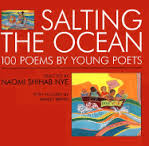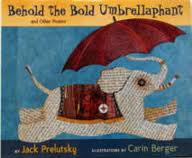 |
| retrieved from readergirlz.blogspot.com on 5/3/2013 |
P*Tag
Authored by: Sylvia Vardell and Janet Wong
Photographs by: Sylvia Vardell
Published by: PoetryTagTime.com
Year: 2011
Kindle Version
ASIN: B005OSJ5PO
Critical Analysis:
In this anthology pictures provided by author Sylvia Vardell, are the
inspiration for a lively game of poetry tag. The rules: a poet it tagged, the
poet chooses a photo from a photo library found at http://teenpoetrytagtime.blogspot.com,
the poet writes a poem inspired by the photo, the next poet must incorporate
three words from the previous poem into his or her poem to keep the poems
connected, the poet writes a short prose “connection” piece explaining how the
poem came to be, the poet tags another poet and so on….
This totally electronic book is absolutely amazing! Specifically geared
toward the teen age crowd, this eBook coincides with a poetry blog for teens
and totally meets them where they are. Sometimes gritty, sometimes funny, and sometimes
requiring a second peruse, or a third, the poems in this book speak to the
complicated lives of teenagers. Poems like Ordinary resonate with those
that struggle to be seen and heard while Broken might speak of the anger
of a shattered relationship that may never be whole again. The feelings evoked can be intense and confusing just like those found within the teenage heart and mind.
Some of the poems are difficult to understand but that does not negate
their beauty. The explanations of the poets thoughts about the photos that are
to be found before each poem often help the reader to visualize the meaning
while the three words that connect one poem to another add a bit of fragile
continuity.
While not an easy read, it is my opinion that it isn't meant to be.
After all, if it is an anthology of poetry geared toward the teenage heart and
mind it shouldn't be easy. They are a complicated mix of adult, child, and
someone in between so this book suits them. Kimberly Marcus’ poem Stamped
is a perfect example of the complexity of teenage lives, fragile loves, intense
thoughts and strong feelings.
I
sealed my heart
fragile,
handle with care,
added
sufficient postage
bought
from
every smooth look you
sent
my way,
the
appropriate address of
compliments,
a
rush delivery of heat.
But
I failed to insure it
against
damages incurred
from
your cold, flat rate
response.
Connections:
This book definitely is a great way to entice students to write a
classroom anthology during National Poetry Month. Bring in a group of
photographs, artwork, and objects to class. Allow student
s to choose one and then
explain the rules and have them write a poem about the object they chose. Be
sure to remind them to borrow three words from the poem of a classmate. This
may take the entire month as someone has to go first and then tag someone else.
Be sure to have plenty of poetry books available to help students develop ideas
about the form and voice they want to use.



